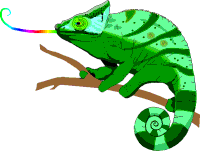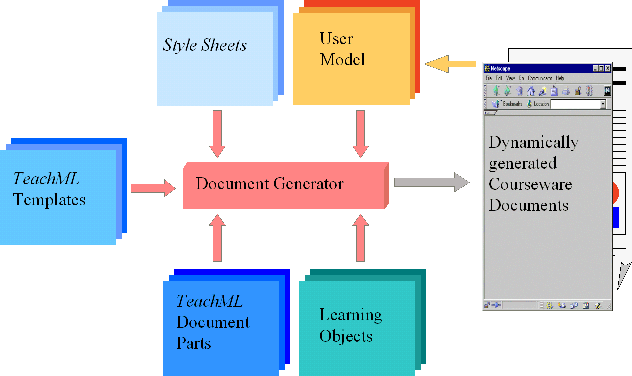








To create interactive multimedia courseware documents adapted to the learner's needs, aims, preferences and learning style is quite difficult. Professional authors and publishers have the technical and didactical skills to create such documents but cannot know the concrete learners and the teaching situation. Teachers know their learners and didactical concepts, but often do not have the time or knowledge to produce media-rich and interactive courseware material.
In order to solve this problem we started the CHAMELEON (Cooperative Hypermedia Adaptive MultimEdia LEarning Objects) project. Our vision is to develop formats for adaptable, extendable and combinable courseware modules, so called "Learning Objects", and for pre-structured document templates. Learning Objects are created by professional authors, programmers, teachers and designers using classical authoring tools and programming environments. Learning Objects are published and charged by publishing houses but they still remain adaptable and extendable. Teachers select Learning Objects approximately matching the current teaching situation, adapt them e.g. to their didactical structure or a specific design, extend them with their own existing contents and combine them into document templates to specific courseware. Therefor teachers need visual tools which allow the selection, necessary adaptations and combinations of Learning Objects without programming.
For easy interchange and platform independent use Learning Objects should base on internet standards and de facto standards like the Java programming language, XML, JPEG and MPEG, but Learning Objects in proprietary formats can also be used.
Learning Objects can be divided into passive (or static) and interactive ones. Passive Learning Objects (e.g. texts, pictures, animations, ...) do not need any interaction with the learner except, e.g. reading or looking at a picture. In other words the learner is consuming their contents. Such learning objects can be expressed with classical document and media formats like XHTML, XML or SMIL. Interactive Learning Objects (simulations, exercises, virtual practical training, etc.) let the learner explore the contents, he or she can change parameters, solve exercises, influence his route through the courseware material or add own comments, links and contents. Interactive Learning Objects can be developed using programming environments or multimedia authoring tools.
The courseware documents are realized with the XML-grammar "TeachML". TeachML consists of several modules, e.g. for didactical structure (templates), contents, exercises and learner's models. The TeachML documents together with interactive and media content are stored in a database. Dependent on the concrete learner's model the document generator selects matching Learning Objects and templates from the database. Stylesheets are used to convert the TeachML document to the needed output format. On client-side information about the learner are available through solutions of exercises or the usage of the help system. This information flows back in order to keep the learner's model up to date. Figure 1 shows the architecture of the document generator.
